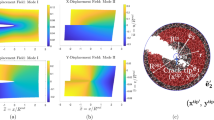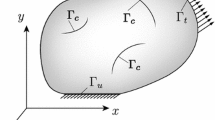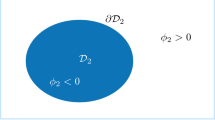Abstract
This paper studies tangential and simplicial data depth for simple orthogonal regression. Given N points in the plane, simple orthogonal regression means that we wish to determine the line through the origin that has smallest distance to the points measured in the direction orthogonal to the line. For both depth notions, it is proved that two lines which are orthogonal to each other, i.e. two lines forming a cross, have the same depth. Depth-based orthogonal regression can thus merely fit crosses, not lines. We investigated the robustness properties of maximum depth estimators using the notion of exact fit. Another topic the paper covers is the testing of the hypothesis that the data points form a cross-like pattern. After a simple transformation, such a test can be based on the biggest data depth. The paper discusses an application of this test for the investigation of stress fractures in materials.
Similar content being viewed by others
References
Bai Z-D, He X (1999) Asymptotic distributions of the maximal depth estimators for regression and multivariate location. Ann Statist 27: 1616–1637
Batschelet E (1981) Circular statistics in biology. Academic Press, London
Besel M, Brückner-Foit A (2008) Surface damage evolution of engineering steel. Fatigue Fract Eng Mater Struct 31: 885–891
Besel M, Brückner-Foit A, Zeismann F, Grüning A, Mannel J (2008) Damage accumulation of graded steel. Eng Fail Analysis (to appear)
Brückner-Foit A, Huang X (2008) On the determination of material parameters in crack initiation laws. Fatigue Fract Eng Mater Struct 31: 980–988
Brückner-Foit A, Meyer S, Möslang A (2003) A stochastic simulation model for microcracks in a martensitic steel. Comp Mater Sci 26: 102–110
Donoho DL, Huber PJ (1983) The notion of breakdown point. In: Bickel PJ, Doksum KA, Hodges JL Jr (eds) A festschrift for Erich L. Lehmann. Wadsworth, Belmont Calif, pp 157–184
Ellis SP, Morgenthaler S (1992) Leverage and breakdown in L1 regression. J Amer Statist Assoc 87: 143–148
Fisher NI (1995) Statistical analysis of circular data. Cambridge University Press, New York
Fletcher DI, Franklin FJ, Kapoor A (2003) Image analysis to reveal crack development using a computer simulation of wear and rolling contact fatigue. Fatigue Fract Eng Mater Struct 26: 957–967
Fujita Y, Mitani Y, Hamamoto Y (2006) A method for crack detection on a concrete structure. Proc Int Conf Pattern Recognit 3: 901–904
Gunkel C, Müller AC, Stepper A, Müller CH (2009) Automatic crack detection and statistical analysis. Submitted
He X, Jurečková J, Koenker R, Portnoy S (1990) Tail behavior of regression estimators and their breakdown points. Econometrica 58: 1195–1214
Ihara C, Tanaka T (2000) A stochastic damage accumulation model for crack initiation in high-cycle fatigue. Fatigue Fract Eng Mater Struct 23: 375–380
Iyer S, Sinha SK (2005) A robust approach for automatic detection and segmentation of cracks in underground pipeline images. Image Vis Comput 23: 921–933
Lee AJ (1990) U-Statistics, theory and practice. Marcel Dekker, New York
Liu RY (1988) On a notion of simplicial depth. Proc Nat Acad Sci USA 85: 1732–1734
Liu RY (1990) On a notion of data depth based on random simplices. Ann Statist 18: 405–414
Ludwig W, Buffiere J, Savelli S, Cloetens P (2003) Study of the intera of short fatigue crack with grain boundaries in a cast Al Alloy using X-ray microtomography. Acta Mat 51: 585–598
Mann KA, Gupta S, Race A, Miller MA, Cleary RJ (2003) Application of circular statistics in the study of crack distribution around cemented femoral components. J Biomech 36: 1231–1234
Mardia KV (1972) Statistics of directional data. Academic Press, London
Mardia KV, Jupp PE (2000) Directional statistics. Wiley, Chichester
Mizera I (2002) On depth and deep points: a calculus. Ann Statist 30: 1681–1736
Mizera I, Müller CH (1999) Breakdown points and variation exponents of robust M-estimators in linear models. Ann Statist 27: 1164–1177
Müller CH (2005) Depth estimators and tests based on the likelihood principle with application to regression. J Multivar Anal 95: 153–181
Pook L (2000) Linear elastic fracture mechanics for engineers: theory and application. WIT Press, Southhampton
Rousseeuw PJ, Hubert M (1999) Regression depth (with discussion). J Amer Statist Assoc 94: 388–433
Tukey JW (1975) Mathematics and the picturing of data. In: Proceedings of the International Congress of Mathematicians, vol 2. Vancouver 1974, pp 523–531
Van Aelst S, Rousseeuw PJ, Hubert M, Struyf A (2002) The deepest regression method. J Multivar Anal 81: 138–166
Wellmann R (2007) On data depth with application to regression and tests. Ph.D. thesis. University of Kassel, Germany
Wellmann R, Katina S, Müller CH (2007) Calculation of simplicial depth estimators for polynomial regression with applications. Comput Stat Data Anal 51: 5025–5040
Wellmann R, Harmand P, Müller CH (2009) Distribution free tests for polynomial regression based on simplicial depth. J Multivar Anal 100: 622–635
Wellmann R, Müller CH (2008a) Tests for multiple regression based on simplicial depth. Submitted
Wellmann R, Müller CH (2008b) Depth notions for orthogonal regression. Submitted
Zar JH (1999) Biostatistical analysis. Prentice-Hall, Upper Saddle River, NJ
Author information
Authors and Affiliations
Corresponding author
Additional information
Research supported by the SFB/TR TRR 30 Project D6.
Rights and permissions
About this article
Cite this article
Müller, C.H. Data depth for simple orthogonal regression with application to crack orientation. Metrika 74, 135–165 (2011). https://doi.org/10.1007/s00184-009-0294-8
Received:
Published:
Issue Date:
DOI: https://doi.org/10.1007/s00184-009-0294-8




